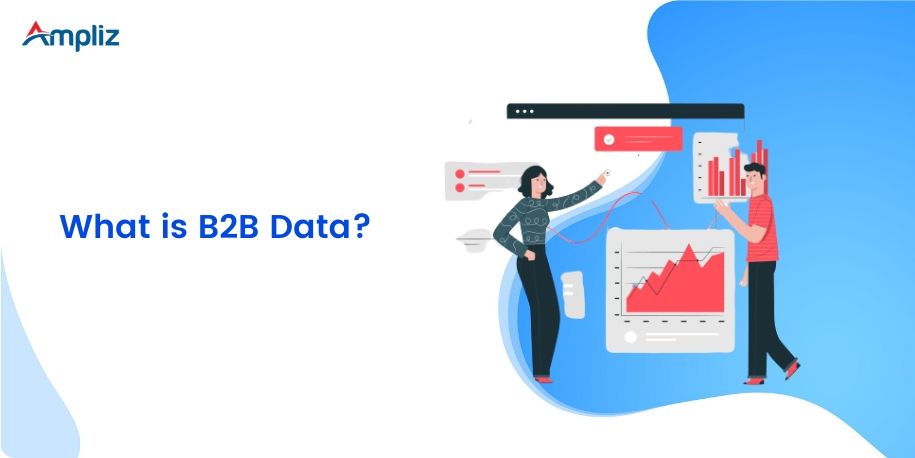Business to business data is the fastest-growing category of online marketing. They are becoming extremely popular due to the fact that they are both profitable and rewarding.
For individuals that are not sure what b2b data is, this article should let you know everything you will ever need to know about business data.
What is B2B Data?
B2B data can be anything from business data, SIC code, product information and any other type of business-oriented data. These are collected in different ways.
B2B data is a big part of any business and it has various types. It comprises all the technical information related to your product or service, such as techno graphical information and firmographics. You can also find ESG factors in B2B database.
Right from selling goods to another company to providing services, you belong to the B2B category when you sell products or services to other businesses.
Prospecting for new buyers is a tough proposition for every salesperson, especially in the B2B domain. It is quite crucial to have a targeted list, which has pre-qualified leads.
Time is money, and it can’t be truer when it comes to sales. We cannot emphasize much on the importance of quality data. And you cannot just buy business leads. You need comprehensive data, but doing that effectively, without losing much time, is very difficult. Let us understand the concept in detail and how you can leverage the learning for your benefit.
B2B Data
B2B or business to business refers to your seller category. When your company sells a product or service to another business, you belong to the B2B category.
B2B data comprises all data related to the business. The common examples are right from techno graphical information to firmographics and ESG (environmental, social, and governance) factors.
These datasets offer a lot of insights about organizations, and their usage is far and wide. Businesses make use of the B2B database for their outreach campaigns to pitch their products and services. When it comes to customer acquisition and retention, B2B data is a very important asset. It provides businesses with new avenues for expansion and success.
The data comprises employee names, company names, email addresses, contact numbers, firmographics, and technographics. Basically, there is every bit of information that can help you qualify a prospect as a good lead. You can then use their contact details to reach out to them.
How can I get B2B Database?
Now that you know what B2B data is, let us look at what are the different ways you can source it. One of these methods includes doing the task in-house, but we recommend you avoid that.
Fill the form and get B2B Data
Let us understand in detail why you should avoid sourcing B2B data in-house.
Never use in-house resources
Sourcing B2B data in-house can look quite enticing if you want to have control over things and ensure a quick turnaround. However, these are not important steps in the process for which you need to worry a lot.
Your marketers and salespersons are important assets, and you must not reduce their roles to simply data researchers. Your sales team is the one that should work on leads and using more time for closing them. Here are some other options you might think of.
- Hiring
Even if you look to look hire data researchers, you already know that hiring can consume a lot of your resources in terms of time and money. Setting up payroll, contracts, and budgets are only a few basics. You will also need office space and resources, which can be concerning, especially if you have a small setup.
You will further have to train your resources for best practices in validating, cleaning, and storing the data. Besides, the turnover of employees is inevitable, and you need to start all over again once that happens. All of this is too much to ask for.
- Subscriptions
You will need multiple tools like LinkedIn Sales Navigator, along with others, to identify the correct data and source it. With multiple subscriptions, you can easily end up spending a lot.
- Resource-intensive
Sourcing quality data is a very resource-intensive exercise, which needs careful consideration. There are multiple steps involved if you need data that can give you traction. Right from learning the methodologies to identifying the tools and buying subscriptions, it can be a time-consuming exercise.
Inaccuracies are also common in email sourcing tools, and still, it will be difficult to source some emails. You might need to rely on the email format used by a company to identify the email addresses. Once you source the data, you might also need to cleanse and validate the data. Inaccuracies can lead to a higher bounce rate in your email campaign and missed opportunities.
Now that we know why you should not do B2B data sourcing in-house, here are two possible solutions to overcome the problem.
- Get in touch with a B2B data partner
A B2B data partner is a bliss that can scale your marketing and sales campaigns to a different level. Be it outbound email campaigns or 1-to-1 outreach on LinkedIn, verified B2B data can surely help you boost your ROI.
Partnering with a global data platform like Ampliz, which comes in the form of an enterprise version as well as a Chrome extension, can be a good choice. It is a B2B global data intelligence platform that can help you find email addresses, contact numbers, LinkedIn ids, and company intelligence in just a single click. - Apart from the contact details of your prospects like email, contact number, and LinkedIn profile, you can also view the target company’s revenue, employee strength, etc.
The data goes through a three-step verification process and is one of the most trusted data sources in the B2B domain. With the help of Ampliz SalesBuddy, your sales team can make the right use of their time by contacting the leads and closing them.
- Use the services of a freelancer
Popular gig platforms like Upwork, Freelancer.com, and PeoplePerHour have a rich B2B database of global freelancers. Depending on your requirements and budget, you can hire a freelancer who can source the data for you effectively. You can set the delivery timeline according to your needs. Though it is cost-effective, there are few drawbacks to this as well.
One of the biggest concerns could be the actual source of the data. If the data did not get sourced keeping in mind the compliances, it can become riskier for you to use it. Cold calling lists can be a risky business if you are dealing with a lot of consumers, therefore your cold call list should be accurately managed and Ampliz can help you do that.
How do you get free business leads?
In this digital era, most businesses are becoming successful because of their online customers. However, getting prospects and converting them to customers is not a simple task. Nurturing and following up with your leads is more important than getting them. Getting quality data is surely an investment, but there are some ways you can use to get leads for free.
- Word of mouth
It is a traditional yet effective way of improving your user base. Giving incentives to spread word of mouth is an effective way of generating leads. All you need to ensure is you provide your existing customers with quality service. They will then become your patrons and help you gain a newer audience. You can leverage platforms like Facebook and Twitter by giving away free giveaways and discounts.
- Existing traffic and communities
You must keep track of your traffic after you launch your campaigns. Get to know from which platform you are receiving the most traffic. You can answer the queries of your customers to build more trust. Communities like Reddit, Quora, and LinkedIn groups can be great sources to build a reputation and attract the audience.
- Cross-sell and upsell
These traditional strategies are still an effective way to generate more leads. You can offer your products or services at discounted rates, along with better support and services. You can also sell partner products at discounted rates to upsell customers.
- Affiliate programs
These programs do not require any investment and are one of the easiest ways to get more customers. All you need to do is to have a substantial commission structure, affiliate management software, and a mechanism to attract the right crowd.
- Free trials
Free trials can attract a lot of people to sign up. Eventually, a sizeable sum can become buyers, which increases both sales generation and leads. However, free trials must only go to genuine prospects that have high chances of conversion.
- Use existing network
Make worthwhile business connections is important as they can help you with referrals. But, before doing that, ensure that you develop good online credibility. It will also help your new prospects understand you better.
- Guest blogging
It can help you generate a lot of buzz around your products and services. Both parties stand to gain from the deal. Community engagement is important, and you can attract the right traffic by delivering quality content.
How do businesses get data?
There are many ways through which businesses get data. Some processes are technical, while some deductive methods are also used to gather data. There are multiple sources of data that help businesses capture data across different metrics. You can collect the data directly from the customer, by indirect tracking, or even using data appending services. For a business to be successful, the data must come from all three sources.
Customer activity on websites and social media platforms are a common source. Another innovative method is using location-based advertising that helps build a personalized data profile. It is an effective way of creating hyper-personalized campaigns for the right audience.
Historic data of existing customers is another source that can be used to study the past buying pattern. Based on the feedback and response, you can build a customer persona. Getting data from a third-party source is another option.
Final thoughts
B2B data is the best tool to help your team build a cold call or email list, which can be used to build the sales pipeline and close the deals. Sourcing the data in-house can be a tough task. Fortunately, a growth partner like Ampliz can help you source B2B data. It will help your sales team spend more time contacting and closing the leads.



